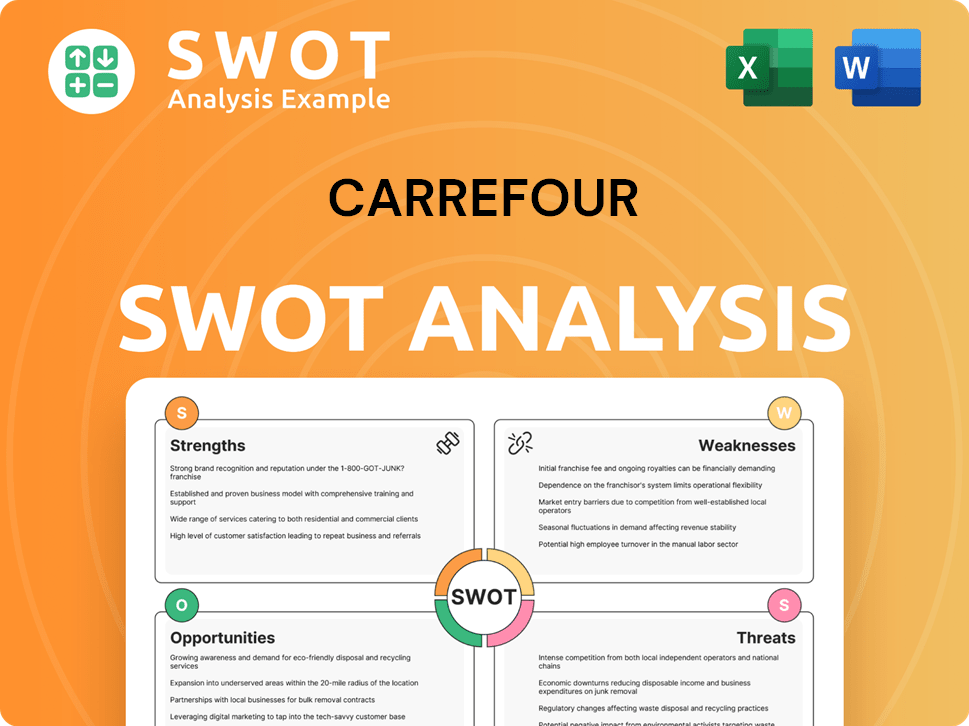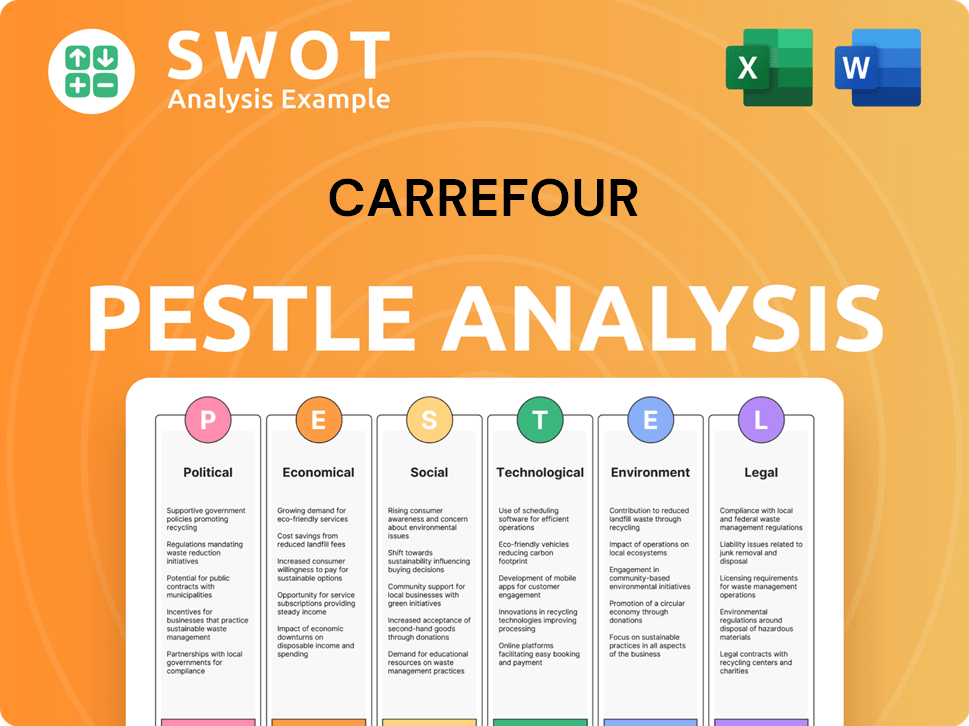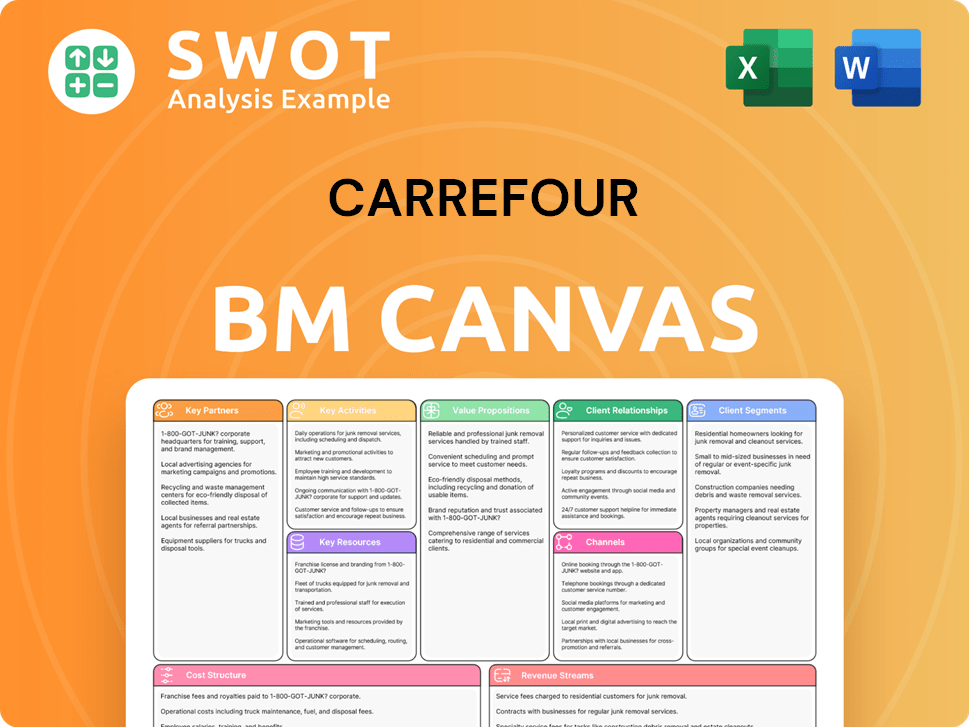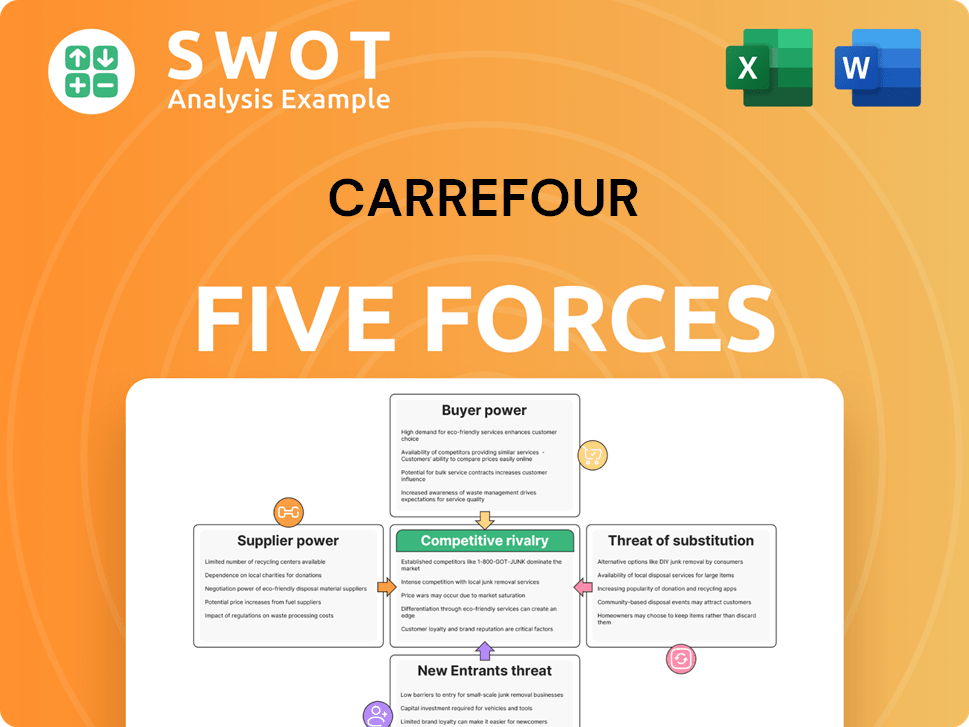Carrefour Bundle
How has Carrefour Adapted Its Sales and Marketing in the Face of Changing Consumer Demands?
Carrefour's journey, from its 1959 inception to its current market position, offers a compelling case study in retail evolution. The company's 'Act For Food' program, launched in 2018, signals a significant shift toward healthier and more sustainable practices, directly influencing its sales and marketing strategies. Understanding Carrefour's approach is crucial for anyone seeking insights into modern retail dynamics and effective Carrefour SWOT Analysis.

Carrefour's current Carrefour sales strategy and Carrefour marketing strategy reflect a complex interplay of its hypermarket legacy and the demands of the digital age. This includes a detailed look at Carrefour market analysis, its Carrefour retail strategy, and how it leverages digital marketing initiatives, social media marketing, and customer relationship management. The company's Carrefour business model has evolved to embrace e-commerce, local sourcing, and a renewed focus on consumer values, making it a fascinating subject for strategic analysis.
How Does Carrefour Reach Its Customers?
The sales channels of Carrefour are a crucial element of its overall Carrefour sales strategy, encompassing a blend of physical and digital platforms. This omnichannel approach allows the company to cater to diverse consumer preferences and shopping habits. Carrefour's strategy is designed to enhance customer convenience and boost its market presence.
Carrefour's retail strategy involves a mix of store formats, from large hypermarkets to smaller convenience stores. The company has been adapting its physical presence to meet changing consumer demands, particularly in urban areas. This adaptation is part of a broader effort to maintain a competitive advantage in the retail sector.
Digital channels play a significant role in Carrefour's sales strategy. The company's e-commerce platforms, including its website and mobile apps, are essential for online grocery sales and click-and-collect services. This focus on digital initiatives reflects Carrefour's commitment to staying competitive in the evolving retail landscape.
Carrefour operates a range of physical stores, including hypermarkets, supermarkets, and convenience stores. Hypermarkets, despite facing some challenges, remain significant, especially in regions like France. The company has strategically expanded smaller formats to meet urban consumer needs. This multi-format approach supports Carrefour's retail strategy.
The company's online presence includes its website and mobile applications. These platforms are key for online grocery delivery and click-and-collect services. Carrefour's digital marketing initiatives have been crucial in adapting to changing consumer behavior. The company's e-commerce strategy has seen substantial growth since 2020.
Carrefour collaborates with various delivery platforms to enhance its last-mile delivery capabilities. These partnerships are essential for expanding its reach and improving customer convenience. This approach is a key aspect of Carrefour's customer relationship management.
Carrefour focuses on providing a seamless customer experience across all channels. Customers can shop online and pick up in-store or browse in-store and order for home delivery. This omnichannel approach is central to Carrefour's brand positioning strategy and its efforts to improve customer loyalty.
Carrefour's sales channels are designed to offer customers flexibility and convenience, integrating physical and digital platforms. This strategy supports the company's goals for growth and market share. The company's approach reflects a deep understanding of its target audience segmentation.
- Hypermarkets and Supermarkets: These traditional formats remain important, especially in certain regions.
- E-commerce and Digital Platforms: Online sales, including grocery delivery and click-and-collect, are experiencing significant growth.
- Strategic Partnerships: Collaborations with delivery services enhance last-mile delivery capabilities.
- Omnichannel Experience: Seamless integration between online and offline channels provides a consistent customer experience.
Carrefour SWOT Analysis
- Complete SWOT Breakdown
- Fully Customizable
- Editable in Excel & Word
- Professional Formatting
- Investor-Ready Format

What Marketing Tactics Does Carrefour Use?
The Revenue Streams & Business Model of Carrefour employs a comprehensive marketing strategy, blending digital and traditional tactics to enhance brand visibility and drive sales. This approach focuses on creating customer engagement and leveraging data analytics for personalized experiences. The goal is to maintain a competitive edge in the retail sector through innovative marketing efforts.
Carrefour's marketing strategy is designed to reach a broad audience while also catering to individual customer preferences. This includes a strong emphasis on digital channels, such as content marketing and social media, alongside traditional methods like television and print advertising. The company’s data-driven approach is crucial for understanding customer behavior and optimizing marketing campaigns.
This multifaceted strategy supports Carrefour's overall business model, aiming to boost Carrefour sales performance analysis and strengthen its market position. The integration of various marketing tactics enables Carrefour to adapt to changing consumer behaviors and maintain relevance in a dynamic retail environment.
Carrefour actively uses digital marketing to drive online sales and engage customers. This involves content marketing, SEO, and paid advertising across various platforms. Email marketing and influencer partnerships further boost digital presence, supporting the online sales strategy.
Content marketing is a key element of Carrefour's digital strategy. The company shares recipes, sustainability tips, and product information on its online platforms. This strategy helps in building brand awareness and engaging customers beyond transactions.
Search Engine Optimization (SEO) is crucial for Carrefour to improve visibility in online searches. Paid advertising campaigns on platforms like Google and social media are used to direct targeted traffic to e-commerce sites and promotions. This approach enhances Carrefour's e-commerce strategy.
Email marketing is used for personalized offers, loyalty program updates, and promotional content. Carrefour leverages customer segmentation to deliver relevant messages. This targeted approach enhances customer relationship management.
Carrefour engages in influencer partnerships, especially with food bloggers and lifestyle influencers. These collaborations promote new products and sustainable initiatives. This strategy helps in expanding Carrefour's brand positioning strategy.
Social media platforms like Facebook, Instagram, and X (formerly Twitter) are actively used. Carrefour uses these platforms for community engagement, customer service, and real-time promotions. This enhances Carrefour's social media marketing.
Carrefour continues to use traditional media, like TV, radio, and print, for broad-reach campaigns. The company uses data analytics to understand customer behavior and personalize marketing messages. This data-driven approach is central to Carrefour's retail strategy.
- Traditional Media: TV, radio, and print media are used for seasonal promotions and brand building.
- Data Analytics: Analytics are used to understand customer purchasing patterns, preferences, and behaviors.
- Customer Segmentation: Data informs customer segmentation, allowing for personalized marketing.
- Technology and Tools: Technology platforms and analytics tools track campaign performance and optimize ad spend.
Carrefour PESTLE Analysis
- Covers All 6 PESTLE Categories
- No Research Needed – Save Hours of Work
- Built by Experts, Trusted by Consultants
- Instant Download, Ready to Use
- 100% Editable, Fully Customizable

How Is Carrefour Positioned in the Market?
The brand positioning of Carrefour centers on delivering accessible, high-quality goods, with a focus on value, convenience, and sustainability. This is a key element of its Growth Strategy of Carrefour. The company's message revolves around 'the food transition for everyone,' highlighting affordable, healthier, and sustainable food options. Its visual identity, often featuring a prominent 'C' logo, conveys trust and dynamism.
Carrefour's marketing communications adopt an approachable, family-oriented, and informative tone, aiming to build community and trust among its customers. The customer experience emphasizes convenience, variety, and a focus on fresh, quality products, both in-store and online. This approach is designed to resonate with a broad customer base.
The company's appeal to its target audience is multifaceted, focusing on competitive pricing and private-label brands to offer affordable choices. Carrefour also attracts consumers seeking quality and freshness, particularly through its emphasis on local sourcing and organic produce. Sustainability initiatives, such as reducing plastic waste, appeal to environmentally conscious consumers.
The core message focuses on 'the food transition for everyone,' emphasizing healthier and sustainable food choices. This commitment is central to its brand identity and marketing efforts. The aim is to make these options accessible and affordable for a wide range of consumers.
The visual identity typically features a prominent 'C' logo, often in red and blue. These colors convey trust and dynamism. This consistent branding helps customers easily identify and connect with the brand across various platforms.
Marketing communications use an approachable, family-oriented, and informative tone. This approach builds a sense of community and trust with customers. The goal is to create a positive and relatable brand experience.
The customer experience promises convenience, variety, and a focus on fresh, quality products. This applies both in-store and online. The aim is to provide a seamless and satisfying shopping experience.
Carrefour offers competitive pricing and private label brands to provide affordable alternatives. This strategy helps attract budget-conscious customers and reinforces its commitment to value. This is a key element of its
The company appeals to consumers seeking quality and freshness, especially through local sourcing and organic produce. This focus on quality helps differentiate it from competitors. This is a key element of its
Sustainability initiatives, such as reducing plastic waste and promoting responsible consumption, resonate with environmentally conscious consumers. These efforts enhance the brand's image and appeal to a growing segment of the market. This is a key element of its
Carrefour strives for brand consistency across all channels, from in-store signage to its e-commerce platform and social media. This consistent approach helps build brand recognition and trust. This is a key element of its
The company actively responds to shifts in consumer sentiment, particularly the demand for ethical and sustainable products. This responsiveness allows Carrefour to stay relevant. This is a key element of its
Carrefour adapts its brand messaging to address competitive threats by highlighting its unique offerings and commitments. This proactive approach helps maintain its market position. This is a key element of its
Carrefour Business Model Canvas
- Complete 9-Block Business Model Canvas
- Effortlessly Communicate Your Business Strategy
- Investor-Ready BMC Format
- 100% Editable and Customizable
- Clear and Structured Layout

What Are Carrefour’s Most Notable Campaigns?
The Carrefour sales strategy and Carrefour marketing strategy are significantly shaped by key campaigns designed to enhance brand image, drive sales, and adapt to evolving consumer preferences. These campaigns often focus on sustainability, digital innovation, and customer engagement. Analyzing these initiatives provides insight into how the company maintains its competitive advantage in the competitive retail market.
One of the most impactful campaigns has been the 'Act For Food' program, launched in 2018. This initiative aims to promote healthier and more sustainable food options. The Carrefour business model has been strategically adjusted to reflect these changes, emphasizing transparency and quality. The campaign has been continuously evolving, adapting to consumer demands and environmental concerns, and solidifying Carrefour's position as a leader in sustainable practices.
More recently, Carrefour has intensified its focus on digital-first campaigns. These campaigns aim to boost e-commerce growth and enhance omnichannel integration, especially following the surge in online shopping. These efforts highlight convenience and speed, with clear calls to action. Collaborations with local producers and initiatives supporting sustainable farming are also frequently showcased in their marketing efforts, reinforcing their commitment to local economies and environmental responsibility.
The 'Act For Food' campaign, launched in 2018, aimed to promote healthier and more sustainable food options. This initiative has significantly enhanced Carrefour's brand image as a leader in sustainable practices. It focuses on transparency, quality, and a commitment to transforming food consumption habits.
Recent campaigns have been digital-first, focusing on e-commerce growth and omnichannel integration. These campaigns highlight convenience and speed, with clear calls to action. They leverage digital channels to reach a broader audience and drive online sales. This approach reflects the company's adaptation to changing consumer behavior.
Carrefour frequently showcases collaborations with local producers and sustainable farming initiatives. These efforts reinforce the company's commitment to local economies and environmental responsibility. Such initiatives resonate with consumers increasingly concerned about sustainability. This helps in creating a positive brand image.
Carrefour's approach to crisis management and rebranding often centers on reinforcing trust and transparency. This is particularly crucial in response to food safety concerns or market shifts. These campaigns aim to maintain customer loyalty and protect the brand's reputation. Transparency is key in these efforts.
Carrefour's marketing campaigns are multifaceted, utilizing various strategies to engage customers and drive sales. These campaigns often feature a combination of in-store promotions, digital content, and traditional advertising to reach a broad audience. The focus is consistently on adapting to consumer preferences and market trends.
- Targeted Promotions: Tailored promotions based on customer data.
- Digital Content: Engaging content across social media and websites.
- Sustainability Focus: Highlighting eco-friendly products and practices.
- Local Partnerships: Collaborations with local producers and suppliers.
Carrefour Porter's Five Forces Analysis
- Covers All 5 Competitive Forces in Detail
- Structured for Consultants, Students, and Founders
- 100% Editable in Microsoft Word & Excel
- Instant Digital Download – Use Immediately
- Compatible with Mac & PC – Fully Unlocked

Related Blogs
- What are Mission Vision & Core Values of Carrefour Company?
- What is Competitive Landscape of Carrefour Company?
- What is Growth Strategy and Future Prospects of Carrefour Company?
- How Does Carrefour Company Work?
- What is Brief History of Carrefour Company?
- Who Owns Carrefour Company?
- What is Customer Demographics and Target Market of Carrefour Company?
Disclaimer
All information, articles, and product details provided on this website are for general informational and educational purposes only. We do not claim any ownership over, nor do we intend to infringe upon, any trademarks, copyrights, logos, brand names, or other intellectual property mentioned or depicted on this site. Such intellectual property remains the property of its respective owners, and any references here are made solely for identification or informational purposes, without implying any affiliation, endorsement, or partnership.
We make no representations or warranties, express or implied, regarding the accuracy, completeness, or suitability of any content or products presented. Nothing on this website should be construed as legal, tax, investment, financial, medical, or other professional advice. In addition, no part of this site—including articles or product references—constitutes a solicitation, recommendation, endorsement, advertisement, or offer to buy or sell any securities, franchises, or other financial instruments, particularly in jurisdictions where such activity would be unlawful.
All content is of a general nature and may not address the specific circumstances of any individual or entity. It is not a substitute for professional advice or services. Any actions you take based on the information provided here are strictly at your own risk. You accept full responsibility for any decisions or outcomes arising from your use of this website and agree to release us from any liability in connection with your use of, or reliance upon, the content or products found herein.